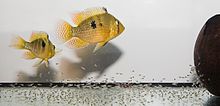Brazilian mother-of-pearl cichlid
| Brazilian mother-of-pearl cichlid | ||||||||||||
|---|---|---|---|---|---|---|---|---|---|---|---|---|

Young Brazilian mother-of-pearl cichlid |
||||||||||||
| Systematics | ||||||||||||
|
||||||||||||
| Scientific name | ||||||||||||
| "Geophagus" brasiliensis | ||||||||||||
| ( Quoy & Gaimard , 1824) |
The Brazilian mother-of-pearl cichlid ( "Geophagus" brasiliensis ), often also known as the mother-of-pearl eartheater or Brazilian mother-of-pearl fish , is a species of cichlid from eastern South America . It occurs in rivers in southern Brazil between Recife and the border with Uruguay .
features
The Brazilian mother-of-pearl cichlid becomes a maximum of 28 centimeters long, but is sexually mature at a length of 8 to 10 centimeters. The body is high and flattened on the sides. The basic color is light olive to medium brown. A vertical band camouflages the eye. Dark spots on the sides of the body are more or less noticeable depending on your mood. The scales on the sides of the body and the unpaired fins have a pearly sheen. The colors of the males are more pronounced, their fins are extended longer, and with age they develop a forehead hump. Females are usually much smaller.
Fin formula : Dorsal XIII – XVII / 9–13, Anale III / 7–10.
ecology
"Geophagus" brasiliensis primarily inhabits smaller rivers and rivers of the clear water type, both in mountainous altitudes and in the coastal lowlands. This earth eater is also found in lakes, ponds, ditches and cultural waters. Apparently, "Geophagus" brasiliensis has a high salinity tolerance, because there are also records from mangrove forests as well as individual records in seawater near the coast near Santos.
Reproduction
Brazilian mother-of-pearl cichlids are substrate spawners . The extensive clutch contains up to 1000 eggs and is placed on a solid surface, usually a stone. Above all, the female looks after the clutch, while the male usually has a larger share in the defense of the territory . Depending on the water temperature, the fry hatch after three to four days and are then housed in a pit at the bottom of the water until they swim free after another four to eight days. After swimming free, the young fish are led by both parents.
Systematics
The Brazilian mother-of-pearl cichlid originally belonged to the genus Geophagus , but was separated from Geophagus by the Swedish ichthyologist Sven O. Kullander during a revision of the genus . Since no new generic name is available for him and a number of other East Brazilian cichlids that originally belonged to Geophagus ( "G." itapicuruensis , "G." minutus , "G." obscurus etc.), the generic name "Geophagus" is used in Quotation marks continued to be used. The Brazilian mother-of-pearl cichlid forms the sister group of Microgeophagus with its relatives .
swell
literature
- Günther Sterba : The world's freshwater fish. 2nd Edition. Urania, Leipzig / Jena / Berlin 1990, ISBN 3-332-00109-4 .
- Claus Schaefer: "Geophagus" brasiliensis. In: Claus Schaefer, Torsten Schröer (Hrsg.): The large lexicon of aquaristics. Eugen Ulmer, Stuttgart 2004, ISBN 3-8001-7497-9 , p. 404.
Individual evidence
- ↑ Lüling, KH (1984): Ecology and fish stocks of some streams in southern and eastern Brazil . Bonn. zool. Contribution 35 (1-3): 221-242
- ↑ Stawikowski, R. & U. Werner (2004): The American cichlids. Volume 3: Erdfresser, Pike and Kammbarsche Verlag Eugen Ulmer, Stuttgart, ISBN 3-8001-3990-1 : 340-352
- ↑ Haseman, JD (1911): Descriptions of some new species of fishes and miscellaneous notes on others obtained during the expedition of the Carnegie Museum to central South America . Ann. Carnegie Mus. 7 (3-4): 315-328
- ↑ Hernán López-Fernández, Kirk O. Winemiller & Rodney L. Honeycutt: Multilocus phylogeny and rapid radiations in Neotropical cichlid fishes (Perciformes: Cichlidae: Cichlinae). Molecular Phylogenetics and Evolution Volume 55, Issue 3, June 2010, Pages 1070-1086 doi : 10.1016 / j.ympev.2010.02.020
Web links
- Brazilian mother-of-pearl cichlid on Fishbase.org (English)
